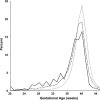Association of preterm birth with brain malformations
- PMID: 19218881
- PMCID: PMC2684939
- DOI: 10.1203/PDR.0b013e31819e7422
Association of preterm birth with brain malformations
Abstract
This study investigates the rate of preterm birth in babies with congenital brain defects. Autopsy case reports of congenital brain anomalies were obtained from the literature. The control cases were from a large registry, a published report from the Metropolitan Atlanta Congenital Defects Program. From 428 publications, 1168 cases were abstracted that had autopsy studies of congenital brain defects and information on the gestational age (GA) at birth. The control data from Atlanta included 7738 infants with significant birth defects of any kind and 264,392 infants without birth defects. In the autopsy cases with brain defects, the mean GA was 36.6 wk, whereas the Atlanta data showed a mean GA of 39.3 wk for infants with no defects and a significantly shorter gestation of 38.1 wk (p < 0.0001) for infants with defects. In the Atlanta data, the rate of preterm birth was 9.3% for those with no defects compared with 21.5% (p < 0.0001) for those with defects. In the autopsy cases with brain defects, the rate of preterm birth was even greater (33.1%, p < 0.0001). In conclusion, these data show an association of brain defects with preterm births.
Figures


Similar articles
-
Diabetes mellitus during pregnancy and the risks for specific birth defects: a population-based case-control study.Pediatrics. 1990 Jan;85(1):1-9. Pediatrics. 1990. PMID: 2404255
-
Outcomes of infants born to mothers with inflammatory bowel disease: a population-based cohort study.Am J Gastroenterol. 2002 Mar;97(3):641-8. doi: 10.1111/j.1572-0241.2002.05543.x. Am J Gastroenterol. 2002. PMID: 11926208
-
Acute histologic chorioamnionitis independently and directly increases the risk for brain abnormalities seen on magnetic resonance imaging in very preterm infants.Am J Obstet Gynecol. 2022 Oct;227(4):623.e1-623.e13. doi: 10.1016/j.ajog.2022.05.042. Epub 2022 May 26. Am J Obstet Gynecol. 2022. PMID: 35644247 Free PMC article.
-
Early births and congenital birth defects: a complex interaction.Clin Perinatol. 2013 Dec;40(4):629-44. doi: 10.1016/j.clp.2013.07.009. Epub 2013 Sep 20. Clin Perinatol. 2013. PMID: 24182952 Review.
-
Neurodevelopmental outcomes of preterm infants.Curr Opin Neurol. 2008 Apr;21(2):123-8. doi: 10.1097/WCO.0b013e3282f88bb4. Curr Opin Neurol. 2008. PMID: 18317268 Review.
Cited by
-
Development of the cerebral cortex and the effect of the intrauterine environment.J Physiol. 2018 Dec;596(23):5665-5674. doi: 10.1113/JP277151. Epub 2018 Nov 2. J Physiol. 2018. PMID: 30325048 Free PMC article. Review.
-
Brain and brain blood vessels histological description in autopsies of fetuses/neonates born to mothers with hypertension during pregnancy. A case-control study.Lancet Reg Health Am. 2024 Nov 27;41:100955. doi: 10.1016/j.lana.2024.100955. eCollection 2025 Jan. Lancet Reg Health Am. 2024. PMID: 39659801 Free PMC article.
-
Risk Scoring Systems for Preterm Birth and Their Performance: A Systematic Review.J Clin Med. 2023 Jun 28;12(13):4360. doi: 10.3390/jcm12134360. J Clin Med. 2023. PMID: 37445395 Free PMC article. Review.
-
A comparison of perinatal outcomes following fresh blastocyst or cleavage stage embryo transfer in singletons and twins and between singleton siblings.Hum Reprod Open. 2023 Mar 8;2023(2):hoad003. doi: 10.1093/hropen/hoad003. eCollection 2023. Hum Reprod Open. 2023. PMID: 36909797 Free PMC article.
-
Child Neurology: Cortical Malformations in Preterm Infants: Case From a Prospective Cohort.Neurology. 2023 Aug 1;101(5):235-238. doi: 10.1212/WNL.0000000000207265. Epub 2023 Apr 18. Neurology. 2023. PMID: 37072221 Free PMC article.
References
-
- Marden PM, Smith DW, McDonald MJ. Congenital anomalies in the newborn infant, including minor variations. J Pediatr. 1964;64:357–371. - PubMed
-
- Yerushalmy J, van den Berg BJ, Erhardt CL, Jacobziner H. Birth weight and gestation as indices of “immaturity.”. Am J Dis Child. 1965;109:43–57. - PubMed
-
- Stewart AL, Keay AJ, Smith PG. Congenital malformations; a detailed study of 2500 liveborn infants. Ann Hum Genet. 1969;32:353–360. - PubMed
-
- Mehes K, Mestyan J, Knoch V, Vinceller M. Minor malformations in the neonate. Helv Paediatr Acta. 1973;28:477–483. - PubMed
-
- Lubchenco LO. The High Risk Infant. WB Saunders; Philadelphia: 1976. p. 217.
Publication types
MeSH terms
Grants and funding
LinkOut - more resources
Full Text Sources
Medical

